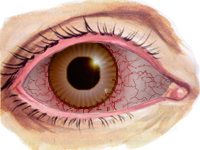Iritis Information
Click here to scroll to the list of available medications ↓
Iritis is either an acute or chronic inflammation associated with the iris of the eye. Iritis can strike patients of all ages and is generally considered an opthalmalic problem. Acute iritis can usually be treated and healed within a few weeks of diagnosis while chronic iritis can last the rest of the patient’s life, although some cases can be cleared up within months or years of diagnosis.
Symptoms may include eye pain, extreme sensitivity to light known as photophobia, blurry vision, cloudy vision, consensual photophobia (which is sensitivity and pain associated with the healthy eye response to light), adhesion of the cornea to the iris or the lens to the iris, and a syndrome known as cells and flare, which indicates a gray haze as well as tiny white dots in the anterior chamber. Most patients experience these symptoms as difficulty with vision as well as painful sensitivity to light. Many patients develop dark spots in their vision with float around and can not be “looked at.” Symptoms have been known to show up overnight or otherwise very quickly.

While some patients develop iritis as a primary condition, many patients experience iritis as a secondary condition. Patients with rheumatoid arthritis, Chron’s disease, lupus, scleroderma, sarcoidosis, Bahcet’s disease, Reiter’s disease, psoriatic arthritis, chronic psoriasis, and ulcerative colitis are prone to developing iritis. Patients with ankylosing spondylitis and other forms of HLA- B27 disorders are also at a high risk for developing iritis.
Patients with tuberculosis, HIV or AIDS, toxoplasmosis, syphilis, trauma to the eye or head, Kawasaki disease, herpes zoster infection, and histoplasmosis are at a very high risk of developing chronic iritis. Patients with these high risk factors should take their eye health into serious consideration while taking care of the rest of their health.
There is a risk of complications associated with iritis, some of which can cause serious vision problems. Complications may include cataracts, calcification of the cornea, glaucoma, posterior uveitis, band, keratopathy, cystoid macular oedema, and blindness or permanent vision impairment. The risk of complications can be reduced with prompt treatment, especially in cases of acute iritis.

Treatment options vary, depending on the severity of the condition as well as whether the patient suffers from acute or chronic iritis. In some cases, prolonged treatment may cause side effects and other unwanted health effects. Patients undergoing treatment for chronic iritis often need to simultaneously undergo careful monitoring for additional health complications brought about by long term treatment. Treatment options may include the use of prednisone or another form of oral steroid, methotrexate or other steroid sparing medicative agents, steroid anti-inflammatory eye drops to reduce the swelling and the pressure, dilating eye drops to help reduce photophobia, eye drop which reduce pressure in the eyes, and steroid injections often delivered behind the eye.
Even with treatment, relapses of iritis are common in patients who develop it once. There is a risk of permanent eye damage associated with each new flare up and patients with vision difficulties and high risk factors should seek out their physician as well as imaging techniques for the spine, brain, and orbital area.